Port Wine Stain Laser Treatment Melbourne
What is a port wine stain?
Port wine stains are birthmarks that are due to congenital malformation of the veins and capillaries of the skin. Present at birth, they affect 0.3 to 0.5% of the population and can have significant psychological implications on the affected individual, especially if the face is affected. Port wine stains commonly occur on the face, but can occur anywhere on the body, and often affect large surface areas.
The appearance of port wine stains, as the name suggests, are a reddish/purple colour, and raised nodules can form within the area. It has been proposed that there is a disturbed innervation to the blood supply of the area, and this often leads to the profound dark and nodular appearance of the affected area.
How are port wine stains treated?
Port wine stains are treated with lasers that are attracted to the haemoglobin (blood) present in the affected area. The first step of treatment, however, is an assessment to confirm the diagnosis, and to exclude any underlying medical problems. This is performed by our medical practitioners. Port wine stains can often lead to increased pressure in the eye (glaucoma), or be a sign of an underlying medical problem (e.g. Sturge-Webber syndrome).
Once an appropriate assessment has been made, laser treatment can be performed. Multiple treatments are required, and there is usually lightening of the port wine stain, but complete removal is often not possible. At Victorian Cosmetic Institute, we treat only the adult population with port wine stains.
Traditionally, the pulsed dye laser has been the laser of choice for the treatment of port wine stains. It has a wavelength of 595nm and is highly attracted to the haemoglobin or the blood in the port wine stain. The heat energy from the laser is preferentially taken up by the port wine stain, and less energy is taken up by the normal skin, thus allowing for selective treatment of the port wine stain. This is a process is called selective photothermolysis.
More recently, port wine stains have also been treated with the 532nm and 1064nm wavelengths of the Gemini laser. The 532nm wavelength is the primary laser wavelength used in treatment of port wine stains. The Gemini laser emits a wavelength of 532nm that is highly attracted to haemoglobin or the blood in the Port wine stain. The 1064nm wavelength is also attracted to the haemoglobin, but not to such a high degree. It does however, penetrate very deeply which helps to compensate for the relatively lower attraction to haemoglobin. The Gemini laser in some studies has been shown to be able to treat port wine stains that are resistant to treatment with pulsed dye lasers. The Gemini laser head also has a cooled-tip to chill the top surface of the skin, which reduces the damage to the surface layer of the skin as the laser passes through to target the abnormal vessels.
Port wine stain nodules may appear in the third to fourth decade of life. These can sometimes be treated with the Erbium laser to help flatten these lesions.
Once again, port wine stains are very resistant to any laser treatments, and usually require multiple treatments. Complete fading is not always possible.
Port wine stain before and after
This is a male in his thirties who presented for treatment of his port wine stain. The Gemini laser was used to treat this condition, and the 532nm wavelength was used. The pictures illustrate the port wine stain before, immediately after laser treatment, and after 2 treatments with the Gemini laser.
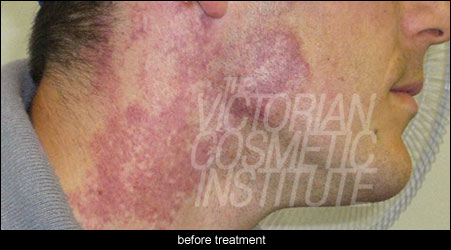
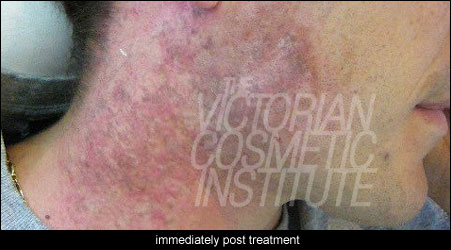
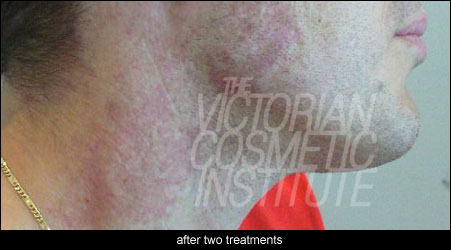
All procedures carry a risk of side effects and potential complications. The outcome of each procedure cannot be guaranteed, and individual results may vary. A consultation with one of our practitioners is required prior to any procedure to assess suitability for treatment. Patient consent has been obtained to display images.
Before and after port wine stain
This is a patient who presented to Victorian Cosmetic Institute with a port wine stain covering her hand and arm. She has had a total of 12 treatments with the 532nm and 1064nm wavelengths on the Gemini laser between the pictured before and after photos.
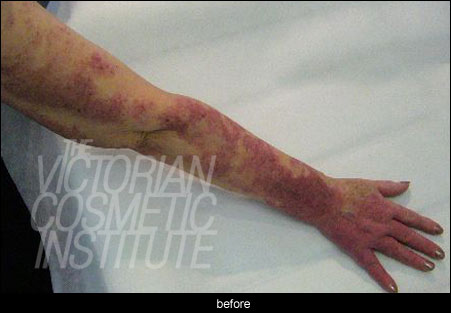
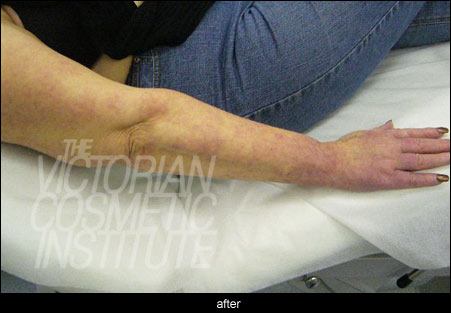
All procedures carry a risk of side effects and potential complications. The outcome of each procedure cannot be guaranteed, and individual results may vary. A consultation with one of our practitioners is required prior to any procedure to assess suitability for treatment. Patient consent has been obtained to display images.
What are the risks and side effects of port wine stain laser treatment?
The area treated may feel hot for a few hours and look sun burnt for a few days. Sometimes there is darkening of the port wine stain initially, and this can take up to a week to fade. If normal skin is affected by the laser, a scab or blister may develop and this can take time to heal. Swelling usually occurs after treatment, and this may take several days to subside. Darker skins are more affected by the laser than lighter or fairer skins. Rare side effects include infection and scarring.
Why should I choose Victorian Cosmetic Institute as my provider of port wine stain laser treatments?
At Victorian Cosmetic Institute, we have doctors highly experienced in the use of lasers performing the port wine stain laser treatments.
The first step is simply contacting us for your initial consultation, where we will discuss with you what is a realistic and achievable outcome, and what to expect from your laser treatment.
Phone our Customer Care team on 1300 863 824 and they will assist in finding a suitable appointment time. Alternatively, you can book online and our team members will contact you to finalise your appointment.
Last updated May 2025
